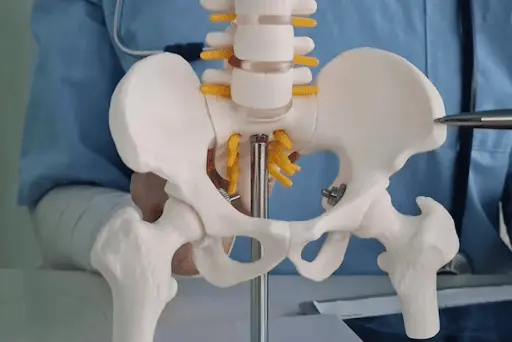Advanced Total Hip Replacement Treatments
Offering expert diagnosis, advanced treatment, and compassionate care for all Total Hip Replacement procedures at VS Hospitals.

Total Hip Replacement
Total Hip Replacement (THR) is a surgical procedure aimed at replacing a damaged or worn-out hip joint with an artificial prosthesis. This procedure is commonly performed in patients who suffer from severe arthritis, injury, or other hip joint disorders. The artificial hip, known as a prosthesis, consists of a metal or ceramic ball, a plastic socket, and a stem that fits into the thigh bone.
Total Hip Replacement has become one of the most successful and life-changing surgeries, helping people restore mobility, reduce pain, and regain independence. It is typically recommended when conservative treatments, such as physical therapy or medications, have failed to alleviate symptoms. The procedure improves the patient’s quality of life by providing pain relief, enhanced movement, and the ability to resume daily activities.

Early Detection Saves Lives
Early detection and treatment are crucial for improving the chances of survival. If you notice any concerning symptoms, consult a healthcare provider immediately.
Signs and Symptoms
Severe Hip Pain
Persistent hip pain that doesn't improve with rest or over-the-counter medications is a primary indicator that the hip joint is severely damaged.
Reduced Mobility
Difficulty in walking, climbing stairs, or getting in and out of a car can be a sign that the hip joint is no longer functioning well.
Stiffness in the Hip
Limited range of motion or stiffness, particularly after sitting for long periods, can signal hip joint degeneration.
Pain During Rest
Pain that occurs even when resting or at night is an indication of advanced joint damage.
Swelling and Tenderness
Swelling or tenderness around the hip, combined with pain, might suggest inflammation or arthritis in the joint.
Blood in Urine
Hematuria - pink, red, or dark urine, the most common symptom
Frequent Urination
Feeling the need to urinate frequently, even when bladder is not full
Painful Urination
Experiencing pain or burning sensation while urinating
Back or Pelvic Pain
Pain that occurs as the cancer grows and spreads
Unexplained Weight Loss
Significant weight loss not related to diet or exercise
Fatigue
Feeling unusually tired or weak without a clear cause
Meet Our Expert Orthopaedic Surgeons – Total Hip Replacement
Risk Factors
Smoking
Smoking is one of the leading causes of bladder cancer. Chemicals in tobacco smoke can damage the lining of the bladder, increasing the risk.

Gender
Men are at a higher risk of developing bladder cancer than women.

Chronic Bladder Infections or Inflammation
Conditions such as bladder infections and long-term bladder inflammation can increase the risk.

Exposure to Chemicals
Prolonged exposure to certain chemicals, especially those used in the dye industry, rubber production, and chemical manufacturing, increases the risk.

Age
The risk increases with age, as the hip joint naturally deteriorates over time.

Arthritis
Osteoarthritis and rheumatoid arthritis are the most common causes of hip joint degeneration.

Injury or Trauma
Past fractures or hip injuries may lead to arthritis or joint damage.

Obesity
Excess weight increases the pressure on the hip joint, speeding up wear and tear.

Genetic Factors
A family history of joint problems may increase the risk of hip degeneration.

Sedentary Lifestyle
A lack of regular exercise can weaken muscles and increase stress on the joint.

Bone Diseases
Conditions such as osteonecrosis (bone death) can cause joint damage and require hip replacement surgery.

Total Hip Replacement
Diet and Nutrition
Prevention
Diagnosis
Key Services
Key Facilities
Diet and Nutrition
Proper nutrition plays a crucial role in maintaining bone health and promoting recovery after surgery. Key aspects to consider include:
- Calcium and Vitamin D: These nutrients are essential for bone strength and healing. Dairy products, leafy greens, and fortified cereals are excellent sources of calcium, while vitamin D can be obtained from sunlight and foods like fatty fish and eggs.
- Anti-inflammatory Foods: To help reduce inflammation, include omega-3 fatty acids (from fish, flaxseeds, or walnuts) and antioxidant-rich foods such as berries, spinach, and nuts.
- Protein for Healing: Protein-rich foods, such as lean meats, legumes, and tofu, are necessary for tissue repair and recovery post-surgery.
- Weight Management: Maintaining a healthy weight reduces stress on the hip joint. Incorporate a balanced diet with fruits, vegetables, whole grains, and lean proteins to maintain a healthy weight.
Prevention
While some risk factors are unavoidable, there are several ways to prevent or delay the need for a hip replacement:
- Exercise Regularly: Strengthening the muscles around the hip joint through exercises like walking, swimming, and biking helps maintain mobility and supports the joint.
- Maintain a Healthy Weight: Reducing excess weight decreases the pressure on the hip joint, helping prevent excessive wear and tear.
- Avoid High-Impact Activities: Activities such as running or jumping put extra stress on the hips. Choose low-impact exercises to protect the joint.
- Good Posture: Proper posture, especially when sitting or standing, reduces strain on the hips and lower back.
- Injury Prevention: Use protective gear when engaging in sports and take measures to prevent falls, especially as you age.
The process of diagnosing whether Total Hip Replacement is necessary typically involves the following steps:
- Physical Examination: The doctor will assess the hip’s range of motion, check for swelling, and evaluate the pain’s intensity.
- Imaging Tests: X-rays are the primary diagnostic tool to determine the extent of hip joint damage. MRI or CT scans may be used for a more detailed view of the joint.
- Blood Tests: In some cases, blood tests may be used to rule out other conditions, such as infections or inflammatory arthritis.
Based on the results of these tests, the healthcare provider will recommend whether Total Hip Replacement is the best course of action.
In a hospital or clinic that offers Total Hip Replacement surgery, several services are available to ensure the patient’s comfort, safety, and recovery:
- Pre-Surgical Consultation: A thorough examination, including diagnostic tests, to evaluate the need for surgery and provide preoperative instructions.
- Pain Management: Various methods are used to control pain before, during, and after the surgery, ensuring a smoother recovery.
- Physical Therapy: Rehabilitation and exercises are essential for regaining strength and mobility after the surgery.
- Post-Surgical Care: Monitoring for complications, wound care, and advice on how to manage daily activities as the joint heals.
- Orthopedic Expertise: Skilled orthopedic surgeons who specialize in hip replacements ensure the procedure is performed with precision.
Hospitals and clinics that provide Total Hip Replacement should have state-of-the-art facilities to ensure the best outcomes:
- Advanced Surgical Theaters: Equipped with modern technology and tools for performing precise and safe surgeries.
- Rehabilitation Centers: On-site physiotherapy and rehabilitation services to assist patients in their recovery.
- Recovery Rooms: Comfortable rooms with nursing care to support the initial healing process following surgery.
- Orthopedic Units: Specialized units focused on bone and joint health, equipped with experts and equipment.
Post-Surgery Monitoring: Facilities that ensure proper monitoring for any signs of infection or complications after surgery.
Top Medical Facilities at Our Multispeciality Hospital – Here’s What Makes Us Different!
Ready to Begin Your Total Hip Replacement Journey?
Learn More About Total Hip Replacement Options
Frequently Asked Questions
The recovery time for Total Hip Replacement typically ranges from 6 weeks to 6 months. Patients can start walking with assistance within a few days, but full recovery, including regaining strength and mobility, may take several months. Rehabilitation and physical therapy are crucial during this time to achieve the best results.
As with any surgery, Total Hip Replacement carries risks such as infection, blood clots, dislocation, or nerve damage. However, these risks are minimized with proper surgical techniques, preoperative care, and post-operative monitoring. It’s essential to follow your doctor’s advice to reduce the chances of complications.
A hip replacement can last anywhere from 15 to 25 years, depending on factors like the patient’s age, activity level, and the materials used in the prosthesis. Regular follow-up visits are necessary to monitor the condition of the implant and ensure it is functioning well.
